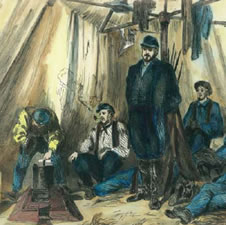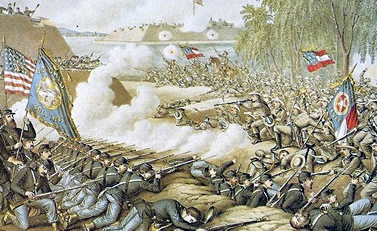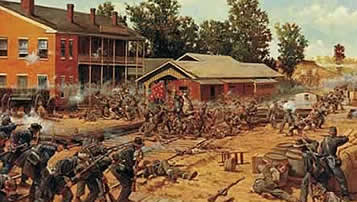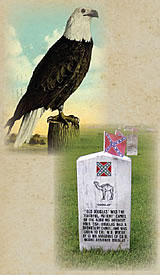|
|
|


|
The Campaign for Corinth
Located in
the hills of Northeast Mississippi is a small area with a significant
past: Corinth and Old Tishomingo County. This region played an
important role in the American Civil War. During 1860, the political
situation in the state of Mississippi as well as the Nation deteriorated.
As a result of Abraham Lincoln's election, Mississippi Governor
John Pettus called for a convention to take place in Jackson,
the state capitol.
Setting
the Stage
Gen. Johnston ordered Gen. P.G.T. Beauregard, his second in command, to gather troops at Corinth. By the end of March, nearly 44000 men, most of whom were "green' were organized into four corps under Generals Leonidas Polk, Braxton Bragg, W.J. Hardee and J.C. Breckinridge. Federal Gen, H.W. Halleck also realized Corinth's value, stating that the railroad centers in Corinth and Richmond were "the greatest strategic points of the war, and our success at these points should be insured at all hazards." He ordered Federal troops to meet at Savannah, on the east side of the Tennessee River.
Confederate
Generals Earl Van Dorn and Sterling Price had not reached Corinth,
but Gen. Johnston decided to strike Gen. Grant's Army of
the Tennessee before the Army of the Ohio, under Gen. Carlos Buell,
could reinforce the troops at Pittsburg Landing. The Confederate
troops left Corinth April 3, but did not reach Shiloh until early
morning April 6, due to rain, mud and inexperience.
Before dawn
April 6, the Confederates attacked the Union forces who had not
entrenched. Although the Confederate Army made a strong showing
on the first day of battle, it experienced a terrible loss when
Johnston was mortally wounded. Gen. P.G.T. Beauregard assumed
command and halted the attack late in the day. During the night
and early morning, 25,500 reinforcements joined Gen Grant, forcing
the Confederates back, and by 4 p.m., they began their painful
trek back to Corinth. The two-day battle, named for Shiloh Church,
was the bloodiest Civil War battle up until that time.
Corinth became a hospital center as the wounded were brought back. Many men died following the battle, not only from injuries sustained in battle, but childhood diseases, dysentery and fevers. Boxcar loads of wounded were sent to Okolona, Columbus and Oxford. The Union army took a month to travel the 22 miles to Corinth. The weather was bad, the water was not good and disease was rampant. Halleck, being cautious by nature, entrenched every night. Eventually there were seven progressive lines and forty miles of trenches. |

|
The
Engagement at Farmington
A
hoax saved Beauregard's army. During the last week of May,
soldiers removed the army's artillery and replaced them with
"Quaker guns," logs painted black to give the appearance
of real weapons. During the night of May 29, the Confederate army
moved out using the Mobile and Ohio Railroad to carry tons of
supplies, heavy artillery and the sick and wounded. When a train
arrived, the troops cheered, camp fires burned and instruments
played, making the Union think that reinforcements had arrived.
The rest of the men slipped away undetected. When Union patrols
entered Corinth, they found the Confederates gone.
After the Confederate evacuation of Corinth, Union soldiers occupied the town. During the long hot summer, they dug wells to find good water and constructed additional fortifications. Gen. Halleck ordered a series of batteries to be built (A through F.) Maj. Gen. Rosecrans built an inner series of batteries (Madison, Lothrop, Tannrath, Phillips, Robinett, Powell, Williams) on the ridges around town which he felt would better protect the railroads. Trenches for infantrymen connected the batteries and abates strengthened the line. |

|
The
Battle of Iuka
During the night, Union commanders moved their men in a more compact position closer to Corinth. The partially entrenched line was less than two miles long and was strengthened at key positions by the cannons located along the College Hill batteries; Batteries Williams and Robinett, overlooking the Memphis-Charleston Railroad; and an unfinished Battery Powell, on the northern outskirts of Corinth. About 9:00, the Confederated opened a savage attack on the Union line. Some Confederates fought their way into town to the railroad crossing. About 10:00, four columns of Confederates advanced on Battery Robinett. They charged three times, each time being mowed down by fire from the battery cannons and the muskets from the men in adjoining fields. After desperate fighting, a Union bayonet charge broke up the enemy columns. By noon, Van Dorn was in retreat. |

|
Davis'
Bridge
Corinth
and the Remainder of the War
|

|
Interesting Facts of the Corinth Campaign * During the Siege of Corinth, conditions were miserable: daily temperatures hovered around 100 degrees; six inches of dust covered the streets from lack of rain; water and soil were polluted from the wastes of 200,000 soldiers and their horses causing many people to suffer from illness called "the evacuation of Corinth."
*
The crossing of the Memphis-Charleston and the Mobile-Ohio Railroads
was considered for a while in 1862 to be the 16 most important
square feet in the Confederacy. Today the tracks are in the same
beds
*
At least 300,000 troops were in or around Corinth during the course
of the war, making it the largest aggregate number of troops ever
assembled in the Western Hemisphere.
*
Approximately 200 top Confederate and Union generals were stationed
in or near Corinth during the war years.
*
Major General Earl Van Dorn (army of West Tennessee) was court-martialed
for his neglect in taking care of logistical details and forcing
his army to march and fight the Battle of Corinth with insufficient
water and food. The charges were dropped.
*
Firing on both sides was so inaccurate that soldiers estimated
it took a man's weight in lead to kill a single enemy in
battle.
*
A Federal expert said that each Confederate who was shot required
240 pounds of powder and 900 pounds of lead.
*
Northern casualties in the Battle of Corinth: 355 killed, 1841
wounded, 324 missing. Casualties from the South numbered: 473
killed, 1997 wounded, 1763 captured or missing.
*
Battle of Corinth Congressional Medal of Honor recipients: James
W. Archer, Army, 1st Lt. & Adjutant, Second Battle of Corinth,
Oct. 4, 1862. William H. Horsfall, Army, Drummer, Siege of Corinth,
May 21, 1862. William W. McCammon, Army, 1st. Lt, 2nd Battle of
Corinth, Oct. 3, 1862. Denis J.F. Murphy, Army, Sergeant, 2nd
Battle of Corinth, Oct. 3, 1862. Wager Swayne, Army, Lt. Col.,
2nd Battle of Corinth, Oct. 4, 1862..
*
Shiloh, site of the bloodiest battle of the Civil War to that
date, means "place of peace."
* Lewis Wallace, Union General, lost his way at Shiloh and his force took little part in the battle. After the war, he was governor of ew Mexic and minister to Turkey, but he is best known for writing Ben Hur.
Old
Douglas
Civil War Nurses in Corinth
|
Home | Coming Events | Places to Visit | Tours | Photos & Video | History | In Their Own Words | Contact
web design byzacksteen.com


 The
Campaign Begins
The
Campaign Begins
 The
Siege of Corinth
The
Siege of Corinth
 The
Battle of Corinth
The
Battle of Corinth
 Old
Abe
Old
Abe
 Kate
Cumming
Kate
Cumming
 Mary
Ann "Mother" Bickerdyke
Mary
Ann "Mother" Bickerdyke